Nonsense botany growing out of nonsense geography. Or is it the other way around? The Jumbly Islands, rife with fantastic flowers. A nowhere out there in the ether, where I first saw them long ago. Far and few, far and few, the lands where the Jumblies live. You can’t get there from here. So where do the borderlands of science and nonsense begin and end? When it comes to our roving Professor Bosh, you can’t get your bearings for all the blurring. On this side, nature drawn from life, a mirror onto nature. On that side, nonsense as second nature, life through the looking-glass. In one domain, a mirror image of Oak-leaved Geranium (Pelargonium quercifolium), watercolor over graphite, signed and dated Twickenham, June 18, 1828. In the other realm, a mock sketch of Puffia Leatherbéllowsa, ink on paper, from Laughable Lyrics: A Fresh Book of Nonsense Poems, Songs, Botany, etc, Boston: Little, Brown, c. 1888. Exhibit A: Pelargonium quercifolium, native to South Africa, plants that evoke a holiday in the sun, says the Royal Horticultural Society, with their rounded clusters of vivid red or orange flowers and bushy leaves, often strongly marked with purple or red. Exhibit B: Puffia Leatherbéllowsa, from the third installation of Nonsense Botany, a spray of orchid-adjacent fire-bellows climbing two-by-two in trim array. Pelargonium an ornamental, does best on a sunny windowsill or in a heated conservatory; not so the handy Puffia with its lobed leathery petals, eminently useful for stoking open fires in Victorian kitchens. All illusion, all allusion, all growing out of the geography of the imagination – the fine art of scientific illustration, the fine line between natural history and nonsense taxonomy, playing tricks on the eyes, playing games with words, all jumbled up somewhere out there on the wild unmapped borderlands of science and nonsense. A mirror onto nature, life through the looking-glass. You can’t get your bearings for all the blurring.
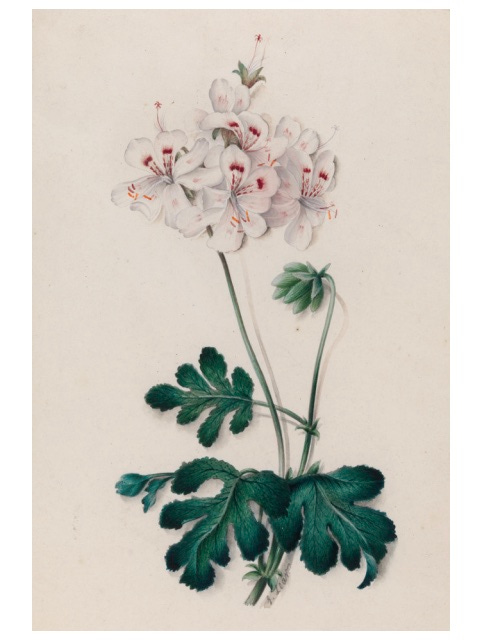
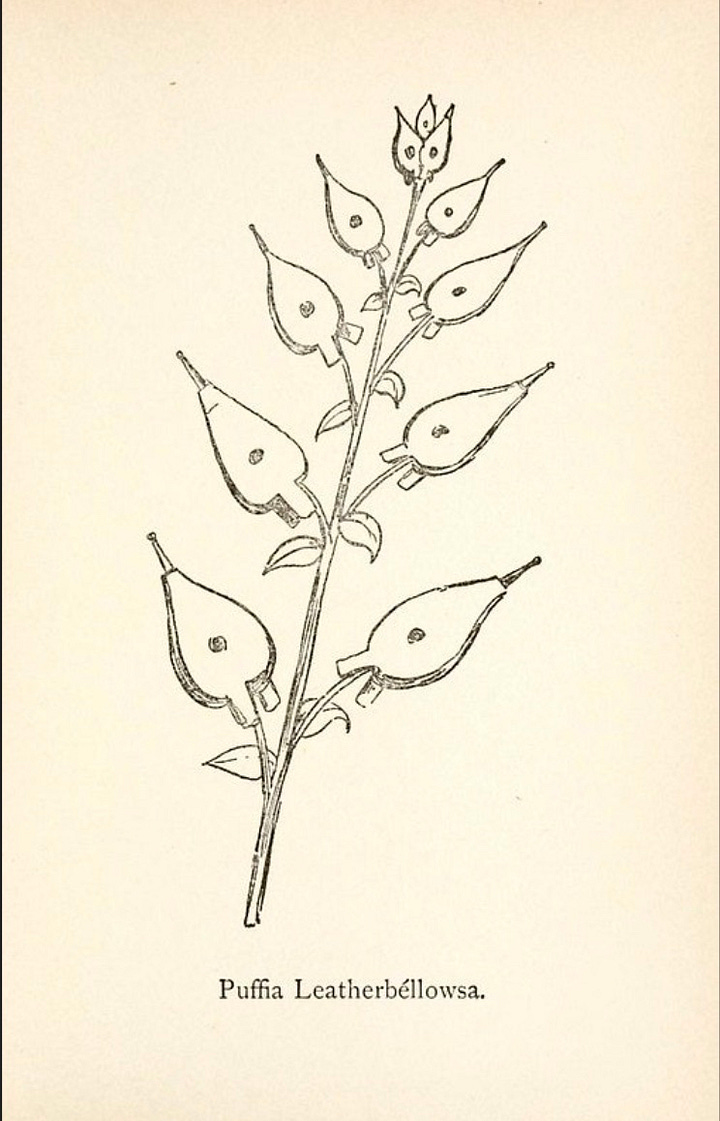
Name-brand nonsense, binomial nonsense the name of the game, nonsense in the name of taking fancy seriously. Dr. Bosh knows his stuff. The Professor is known for upping his game. He’s been at it for ages now. He’s an associate at the Linnaean Society, and a contributor to the Nonsense Gazette. He knows his Macrcercus aracanga from his Cockatooka superba. He’ll never mistake a Testudo pardalis for a Pollybirdia singularis. His learned and valued contributions to the aviary and the nursery and the aristocracy are well known to all the world. Once upon a time, back when no one knew he was Old Derry Down Derry, he did a stint as drawing-master to the Queen. He’s nothing if not well-rounded – or as he likes to put it, perfectly spherical. As any subscriber to the Nonsense Gazette can tell you, he’s not here to draw a bright line between seriousness and silliness. Mad for tropical foliage, wild for botanical trompe-l’oeil. Wild for his garden hyacinths, mad for my Higher-Cynths & also my Lower-Cynths. Look, a letter by post from Calcutta: The way . . . drove me nearly mad from sheer beauty and wonder of foliage. O new palms!!! O flowers!! O creatures!! O beasts!! Look, a preliminary study for the title page of his apprentice work-in-progress Sketches of Animals in the Zoological Gardens, circa 1829, ink wash over graphite – in the background a pair of tall shaggy desert palms, misty summits, daubs that could be evergreens, and in the foreground a lounging lion, paws crossed benevolently, kicking back with a llama, a camel, a dozing owl, two snuggling hyenas, two bobbing ostriches or maybe they’re resurrected elephant birds, all implausibly at ease, all inconceivably tranquil, all impossibly peaceful, a peaceable kingdom. Straight from scripture, The Book of Isaiah 11: The wolfe also shall dwell with the lambe, and the leopard shall lie downe with the kid: and the calfe and the yong lyon, and the fatling together, and a litle child shall leade them. A holy vision, a prophecy, prophecy an exalted form of what comes to be called fancy, fancy from the Greek phantazesthai, to make visible, to have visions, seeing things, same root and branch as “fantastic” and “fantasy,” fancy in its most elevated form rising to the empyrean reaches of what we all now call imagination. Fancy that, a peaceable kingdom, zoology lying down with theology, the lamb getting on fantastically with the lion, no line in the sand with classification over here and imagination over there. Precocious stuff, still something of a child himself, the child the father to the man who calls himself Dr. Bosh, already practiced in the fine art of being none too certain where the scientific method ends and the suspension of disbelief begins. The good professor knows his stuff and nonsense, always game for some good-natured bosh, Bosh his pen-name for taking the palm in nonsense, consummate nonsense in the name of taking seriousness with a grain of salt.
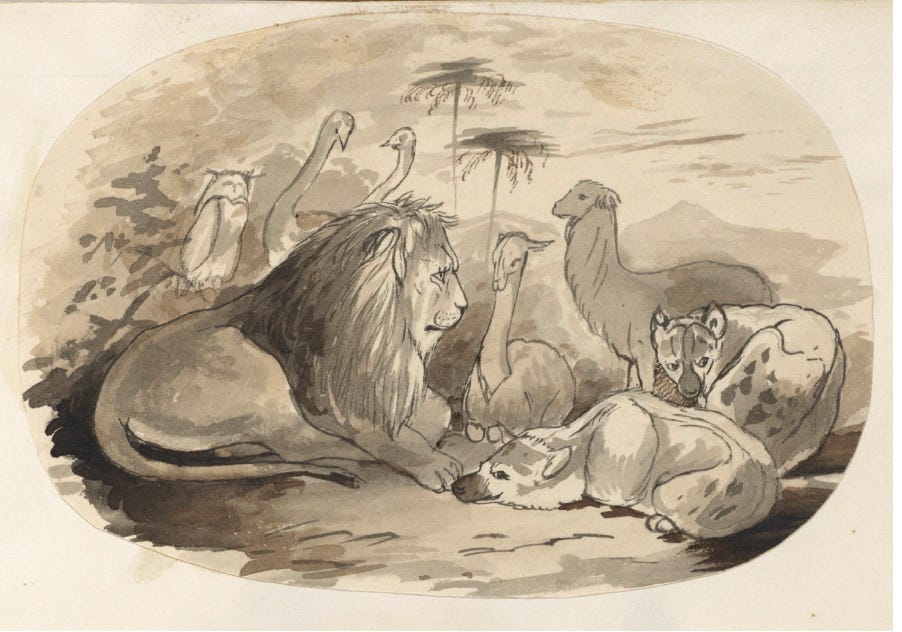
Nature drawn from life, parrots at the zoo drawn with a touch infinitely superior to Audubon’s in softness and the drawings as good in one leading naturalist’s words, a red-and-gold macaw equal to any figure ever painted by Barraband or Audubon for grace of design, perspective, or anatomical accuracy, the drop-dead parrot book so ballyhooed Audubon himself had to have one. Nature drawn with something like second nature, not just South American toucans and macaws but South American trees and vines to put them in, not just colored plates of birds for the Ornithology pages of The Zoology of Captain Beechey’s Voyage (1839), but turtles and tortoises from every latitude and assorted quadrupeds and shipped live to Lord Derby’s menagerie from Down Under like the eastern grey kangaroo (Macropus giganteus) and the eastern spotted-tail quoll (Dasyurus maculatus), drawn from life in all their zany upside-downishness. Nature drawn to order for a living, doing his thing in the menagerie and aviary all the livelong day a strangely befitting training in the nonsense trades, his gleanings from the animal kingdom furthering his education in topsyturvydom as you can see from Gleanings of the Menagerie and Aviary at Knowsley Hall, his life-drawings supplemented with detailed descriptions by Edward Gray, the longtime keeper of the zoological collections at the British Museum, birds drawn from life but some on the list – the Whiskered Yarke and the Piping Guan, the Jungli-bukr and the Ging-e-jonga – sounding like they must be native to the Jumbly Islands or the Valley of Verrikwier. Nature drawn from life, nonsense ingrained in the nature of things, natural history its own branch of nonsense what with that happy penchant for being carried away by the impulse to make our rather artificial and grandiloquent science see the absurd side of its own pedantry, chirped an 1871 Spectator notice. Nonsense Botany like life-drawing an art of illusion only a little more artificial than the real, a natural gift for botanical nonsense in the name of binomial knowhow on full display in that first run of nine sorts of very rare specimens, best of all, perhaps, the Nastycreechia Krorluppia, a vegetable Mercury’s wand, precisely resembling a thoroughly stripped branch of a shrub all covered with caterpillars, unless of course you like your purest botanical nonsense a little less true-to-life.
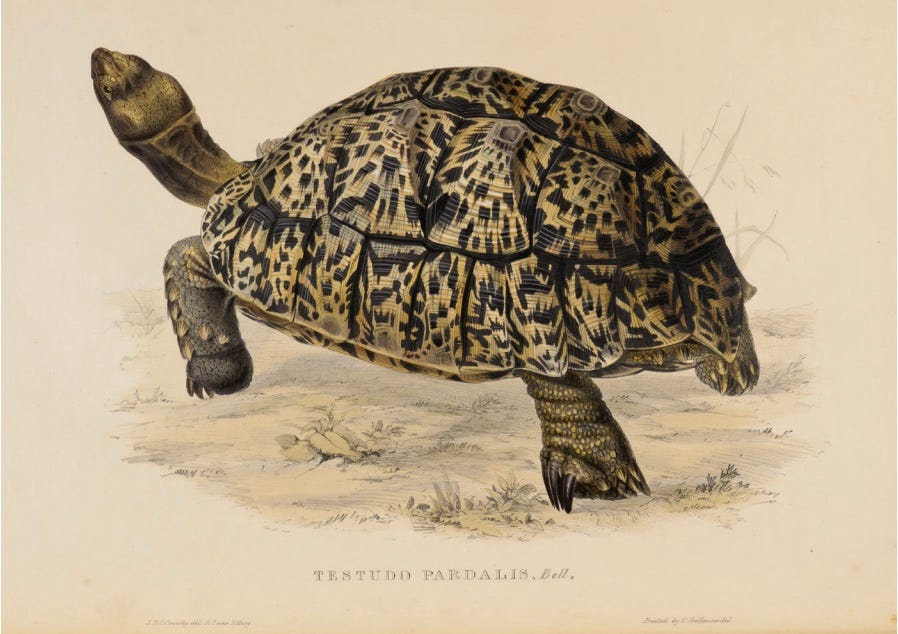
Gleanings from the Menagerie and Aviary at Knowsley Hall, privately published (1846). A Book of Nonsense, by Derry Down Derry, privately published (1846). Same time, same place. Same eye, same hand, work and play one and the same see-saw. Nature drawn from life. Nonsense raised to an art. Name-brand nonsense, nonsense a term of art. Nature drawn from life, nonsense ingrained in the nature of things. Life studies, nonsense drawing a bead on human nature. Nonsense a term of art for playing hooky from the natural order of things. For drawing us the most delightful pictures of plants, only a little more artificial than the real, drawing on his life studies in natural history for inspiration in the fine art of fantasy taxonomy. For pulling a fast one on the Argument from Design, delighting in daring you to concede that sheer nonsense has nothing on natural selection. For allowing the nature-lover a fleeting respite from what his old friend Lord Tennyson ominously pronounced Nature red in tooth and claw. For plying all the budding armchair naturalists out there with Armchairia Comfortablis, a nosegay of binomial nonsense that couldn’t be more disarming in instilling the comfy sense that there’s more than one way for a child of nature to wind up sitting in the catbird seat. For getting the last laugh on the naysayers given to saying that nonsense is nonsense and nomenclature is nomenclature and never the twain shall meet. Look here, three species of the greater Psittacidae family, an indigo macaw, a cockatoo, and a red-and-blue parakeet, all paying taxonomic tribute to his life studies, his Latinized name living on in classic Linnaean fashion – Anodorhynchus leari, Lapochroa leari, Platycercus leari. Name-brand nonsense, nonsense a term of art.
Click through it all as a slide-show and it could be a silly season’s worth of nonsense seed packets, seeds of hooey and tomfoolery, seeds for sowing lunacy and poppycock. Seeds for cultivating patches of fishy or feathery flowers, rows and rows of cutlery and gadgetry aloft on their fronds, blooming bells and bills breaking out all over. Each one drawn true to life on the top flap, stamped with its name, pictured ready for picking. Seed packets that go chuckle-chuckle-ha-ha when you shake them in your wackiest dreams. Jinglia Tinkettlia: grassy blades crowned with a luffing spray of teakettles tinkling and jingling. Enkoopia Chickabiddia: a hen in her calyx-coop athwart a big fanning leaf as her little-bitty chicks hunt and peck, the whole clutch in full flower. Bubblia Blowpipia: a leaf-shaft of full-blown soap-bubbles balancing on their pipe-bowls all the way to the top, lovely to look at but tricky to pluck. Minspysia Deliciosa: the oddest one out, eleven savory little pies (count ‘em) on what looks all too ickily like a toadstool tabletop, but let’s not mince words, toothsome they must be. Each one drawn life-like all by itself on the top flap, seed packets that go snicker-snicker-ha-ha when you shake them just for kicks.
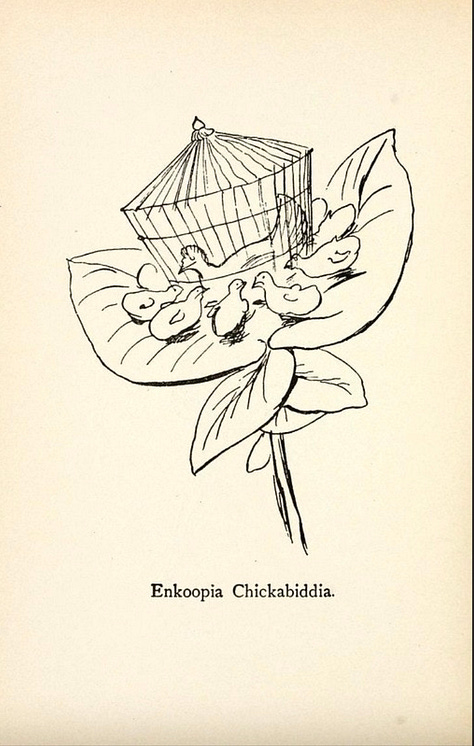
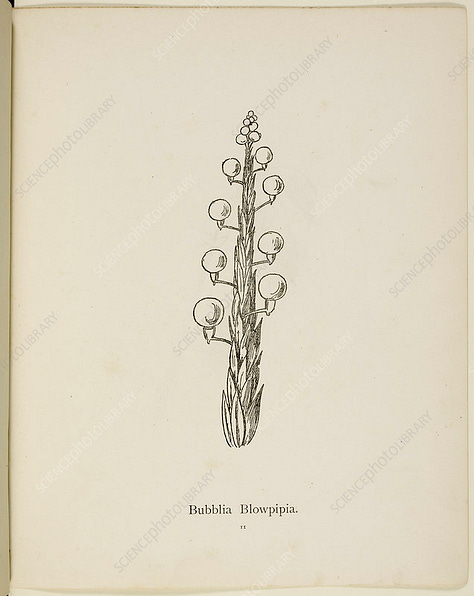
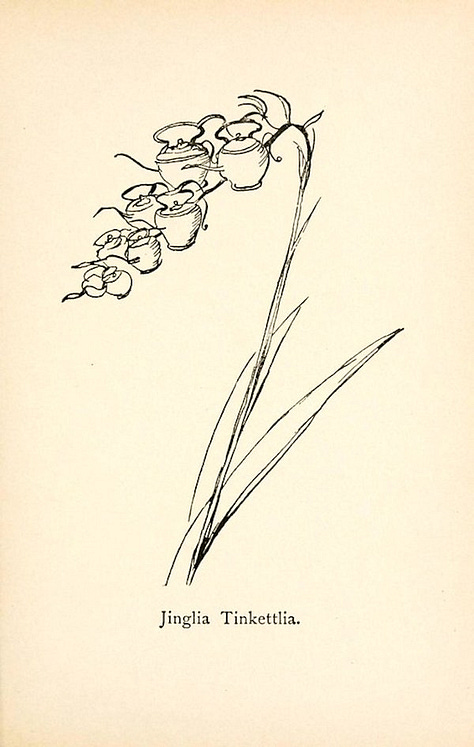
Three installments in all, the whole thing making for an anthology, a gathering of flowers. Nonsense Botany notably a gathering of nonsense flowers, binomial by nonsense binomial, a running anthology of fixated floral nonsense. Flowers in the form of fish, fowl, clocks, boots, brooms, bells, blue-bottle flies – all drawn on the spot before the inkwell runs dry. All very rare, and rarer still the findings from another branch of botany, field studies in Nonsense Trees. Undated, very late, a bit half-hearted by the looks of it, no entries herewith for the nonsense trees in the songs and verses (the Crumpetty Tree, the Bong-tree, the Calico Tree for the makings of Calico Jam and Calico Pie), not even Linnaean binomials this time, just a handful of drawings glossed with a few short notes. Sparse to say the least, scarcely amounting to a last hurrah, specimens mostly shadows of erstwhile botanical nonsense – the Biscuit Tree, The Clothesbrush Tree, The Fork Tree, the Rabbit Tree, the Kite Tree, the Dish Tree. Traces of the old charm but the ingenuity on autopilot, the only inkling of fresh waggishness the thumbnail descriptions reading like foreshadowings of field guides to come. No Latin name for the Biscuit Tree, nonsense taxonomy swapped out for nonsense forestry, morphology, ecology:
This remarkable vegetable production has never yet been described or delineated. As it never grows near rivers, nor near the sea, nor near mountains, nor valleys, nor houses – its native place is wholly uncertain. When the flowers fall off, and the tree breaks out in biscuits, the effect is by no means disagreeable, especially to the hungry, – if the Biscuits grow in pairs, they do not grow single, and if they ever fall off, they cannot be said to remain on. –
Pretty good stuff, the effect by no means disagreeable, especially to those hungry for any stray crumbs of nonsense on the paper trail. Nicely calibrated, the mock-pedantic tone of many an early naturalist, the comically fastidious syntax, the elaborate gobbledygook of arboreal detail. Everyone knows that somewhere out there biscuits grow on trees – cookies, if you’re Stateside – if only some intrepid someone could discover where on earth they flourish. Nonsense, you say? Surely you’ve heard of that sylvan wonder in the genus Theobroma, literally the food of the gods, Theobroma cacao, to be specific, cacao from the Nahuatl cacahuatl, “bean of the cocoa-tree,” the tree that bears the beans with the seeds from which we confect that divine sustenance known the world over as chocolate. Sometimes it’s even baked into biscuits. Sounds like something out of an anthology of Nonsense Trees, you bet, but as any devout sweet-tooth will tell you, tasting is believing.
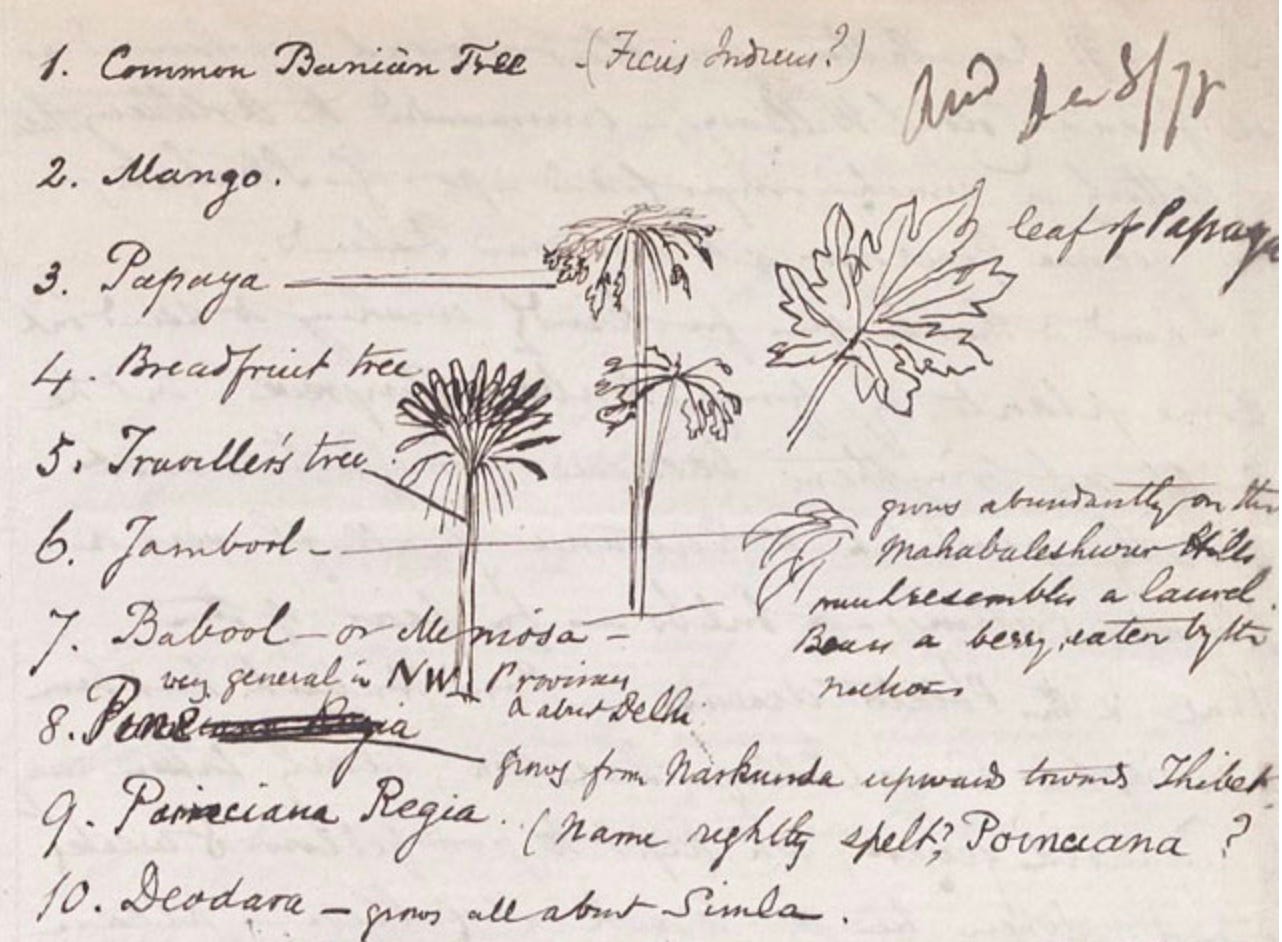
Nonsense genus, nonsense species. Nonsense nomenclature, binomial nonsense. Tickia Orologica, bristly wheat-like stalk, flowering panicles of pocket-watches. Ticking and tocking, just in time for nonsense season. Nonsense, some now say absurdity. Could be two names for the same thing, but not really. Nonsense, sometimes prickly mockery under cover. Absurdity, oftentimes whimsy’s dark familiar. Nonsense botany maybe nothing but nonsense for nonsense’s sake, maybe not. Silly stuff on the surface, yes, but sometimes a sense it could all be a sendup. Smalltoothcombia Domestica, hairy stem sprouting a dozen fine-tooth thingamabobs, just the thing for domesticating all those bushy Victorian moustaches. Nonsense genus, nonsense species, nonsense botany beginning to look like nonsense in the name of a little something to lampoon. Binomial nomenclature the name of the game, every little thing getting identified and classified by name in keeping with the Linnaean binomial system, the system making perfect sense in theory but in practice unleashing a mania for airtight order in the cataloguing of species, all too easily pushed to the point of absurdity. Even Darwin says so, in a letter to Royal Kew’s Sir Joseph Hooker: It is really laughable to see what different ideas are prominent in various naturalists minds, when they speak of “species” …. It all comes, I believe, from trying to define the undefinable.
Nonsense genus, nonsense species, nonsense botany beginning to look like a way of sending up old saws like “Time flies.” Tempus fugit in Latin, first coined in Virgil’s Georgics, but a shopworn cliché in English since time immemorial. The Georgics a long didactic poem in four books on how to grow and raise things in the fields, the catchphrase once a common motto on sundials and sometimes gravestones. Tickia Orologica, bristly wheat-like stalk, flowering panicles of pocket-watches, all the flower-faces telling different times, some of them already gone to seed. Another specimen of botanical nonsense, time flies when you’re having fun. Stuff and nonsense, but try telling that to our industrious botantist Linnaeus. Here he is in his 1751 treatise Philosophia Botanica drawing up a prospectus for a Horologium Florae, a flower clock. Nonsense Botany? Not a chance – he’s kept close watch over his gardens in Uppsala and taken meticulous notes on a number of plants that open or close their flowers at set times of day. He drafts a plan for a garden that would run like clockwork, plantings arranged species by species in a circle so that their flowers would be telling time all across the sundial. He’s done his homework and he’s no-nonsense about it: The time also of solar flowers opening and shutting should be made out in every climate, that any one, without the help of a clock, or seeing the sun, might know the time of the day. A folly, no flower clock would ever work in the real world, but what a fun way to kill time. Kind of like “picking your dream sports team of all time,” says Aussie “plant punk” botanist Tim Entwisle, “or forming the world’s best super band.” Time flies, time flowers. The old saw made new. Time goes to seed when you’re not having fun. Tempus fugit, Tickia Orologica, Horologium Florae, flowers opening and shutting, petals ticking and tocking, Botanical Philosophy meets Nonsense Botany. Comes a time when there’s no telling where one begins and the other ends.
[Third in a series]
Botanica Queeriflora: Notes Towards a Field Guide to Edward Lear’s Nonsense Botany
Part 1 https://postcardsfromthevolcano.substack.com/p/botanica-queeriflora
Part 2 https://postcardsfromthevolcano.substack.com/p/botanica-queeriflora-3e6








